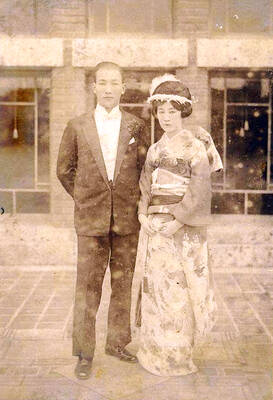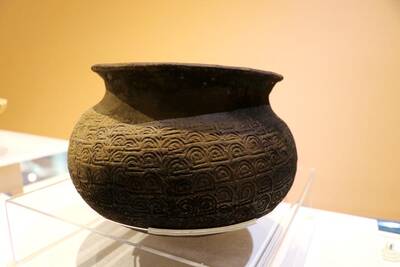To understand Europe’s growing fascination with the wide-eyed innocents and baroque demons of the Japanese comic books known as manga, it may help to look back at the end of the 19th century.
“I envy the Japanese the extreme clarity that everything in their work has. It’s never dull, and never appears to be done too hastily,” the artist Vincent Van Gogh wrote to his brother Theo in 1888.
Van Gogh, whose boldly outlined, vivid painting is now instantly recognizable, copied some of the Japanese woodblock prints by Utagawa Hiroshige that are considered precursors to manga, which roughly translates as “freeform pictures.”
“Their work is as simple as breathing, and they do a figure with a few confident strokes with the same ease as if it was as simple as buttoning your waistcoat,” he wrote.
With bold black lines and graphic coloring, Hiroshige’s prints were delicate — Van Gogh’s 1887 painting of a flowering plum tree, a copy of a Hiroshige print, hangs in Amsterdam’s Van Gogh museum.
Fast-forward through the industrial and nuclear age, the cultural might of the US and ensuing backlash against Mickey Mouse, and there is a logic to the appeal for a generation of Europeans of the hyperbolized cartoon characters.
Young adults are a growing market in publishing: Walk into a bookstore in a European city on a Friday or Saturday afternoon and you can find teenagers crowded in front of a wall of the comic books — a sight nearly nonexistent a few years ago.
HARAJUKU-AM-RHEIN
On Duesseldorf’s Immermannstrasse, an avenue lined with shops catering to the city’s Japanese population, is a scene that could come straight from Harajuku, where Tokyo’s youth congregate — except the butcher around the corner sells sausages.
German teenagers dressed as Japanese goth rock stars, with multi-colored hair and heavy eyeliner, mingle with Japanese schoolchildren in a bookstore on the street, giggling as they step into purikura photo booths that shoot instant snapshots that people decorate themselves and print as stickers.
“They have something special,” said Berenike Schmoldt, whose fascination with manga has turned the German teenager into a full-blown Japanophile at 17, during a Friday expedition with her friends. “I spend hours every week reading them.”
Already fluent in basic Japanese, she is making her fourth visit to Japan this month to soak up the culture, eat her favorite dish of yakisoba fried noodles, and read manga.
It’s a scene replicated in Amsterdam, Brussels, Paris and Rome: local bookshops have expanded their manga sections and feature hundreds of French, Dutch and Italian titles. Often without the credit cards to shop online, these teenagers visit the stores as part of their social life.
“It is something that is much more than a fad,” said Paul Gravett, a publisher and expert on comics in Europe.
“The term ‘manga’ is becoming a global word.”
HUGE POTENTIAL
Sales of printed manga books have fallen in Japan in recent years but grown elsewhere, particularly among European young people who are consuming such titles as NARUTO, Fruits Basket and Death Note with the same appetite as an earlier generation showed for The Adventures of Tin Tin and The Adventures of Asterix.
Often featuring movement that spills across an entire page, manga artists like to push creative boundaries, inventing entirely different worlds or delving deep into human emotions.
The comics themselves are read from right to left and printed mainly in black and white on smaller pages than European comics, which are usually in full color.
In Europe manga is an estimated 38 million euros (US$56.5 million) market, according to the Japan External Trade Organization’s latest data. This is but a fraction of Japan’s 480 billion yen (US$5.3 billion) manga market, but its potential could be huge: Europe’s population of 500 million dwarfs that of Japan’s 126 million.
Recent trends suggest the manga market in Europe is expanding at a pace of 10 percent to 15 percent each year according to data from JETRO and publishers.
MANGA M&A
Where manga may once have felt distinctly Japanese or weird, it is striding into the mainstream. As marketing executives in Asia explore its potential for product placement, the Japanese Embassy in London held a manga competition last year to recruit manga talent from beyond the country’s borders.
Earlier this year, two of Japan’s top three publishers, Shogakukan Inc and Shueisha Inc, moved to gain greater control over their manga and anime networks in Europe, buying out animation distributor KAZE as well as its VIZ Media subsidiary to tap into demand.
Disney-ABC Cable Networks Group in September announced a deal with VIZ to bring a NARUTO series to US TV audiences.
“It is 100 percent certain that manga is [going to be] established for a long, long time,” said Cedric Littardi, president of Paris-based KAZE.
“The readership of manga in numbers of people is increasing every single year in every single European country.”
PSYCHOLOGY
In Japan, manga is ubiquitous, read by young and old alike, with genres across the entire spectrum. From fantasy and pornography to archaeology, cooking, pre-school and business strategy, it leaves few topics unexplored.
While Tin Tin offers complex mystery plots that can still enrapture adults, Death Note by writer Tsugumi Ohba and manga artist Takeshi Obata is a fiendishly complex psychological crime thriller that spans an arc of 108 chapters.
“The challenge is to get the hottest series around,” said Peter Langedijk, buyer of manga titles at Amsterdam’s ABC bookstore. Currently at the top of his list is Vampire Knight alongside perennial favorites such as Dragon Ball and NARUTO.
ANIME OPENED DOORS
As Van Gogh shows, manga’s influence isn’t new in Europe: the modern comics made their first major inroad with Katsuhiro Otomo’s dystopian science fiction classic Akira 20 years ago.
“Akira was a turning point,” said Paul Herman of French comics publisher Glenat. He, like many manga fans, distinguished between the cult of the manga comic and the influence of manga-style art in anime, the poor-quality TV cartoons that have spawned countless children’s TV programs.
“Some bookshops told me they would never sell manga. The perception of manga was clouded by anime on TV, where quality was bad,” Herman said at the Belgian Comic Strip Center in Brussels.
But the fact that such anime from Japan as Doraemon have been available since the 1970s helped manga find a market.
“France, Italy and Spain all have long histories of anime broadcasting,” said John Easum of KAZE. “For this reason the current generation of young parents is receptive to Japanese content.”

Sept. 1 to Sept. 7 In 1899, Kozaburo Hirai became the first documented Japanese to wed a Taiwanese under colonial rule. The soldier was partly motivated by the government’s policy of assimilating the Taiwanese population through intermarriage. While his friends and family disapproved and even mocked him, the marriage endured. By 1930, when his story appeared in Tales of Virtuous Deeds in Taiwan, Hirai had settled in his wife’s rural Changhua hometown, farming the land and integrating into local society. Similarly, Aiko Fujii, who married into the prominent Wufeng Lin Family (霧峰林家) in 1927, quickly learned Hoklo (commonly known as Taiwanese) and

The low voter turnout for the referendum on Aug. 23 shows that many Taiwanese are apathetic about nuclear energy, but there are long-term energy stakes involved that the public needs to grasp Taiwan faces an energy trilemma: soaring AI-driven demand, pressure to cut carbon and reliance on fragile fuel imports. But the nuclear referendum on Aug. 23 showed how little this registered with voters, many of whom neither see the long game nor grasp the stakes. Volunteer referendum worker Vivian Chen (陳薇安) put it bluntly: “I’ve seen many people asking what they’re voting for when they arrive to vote. They cast their vote without even doing any research.” Imagine Taiwanese voters invited to a poker table. The bet looked simple — yes or no — yet most never showed. More than two-thirds of those

In the run-up to the referendum on re-opening Pingtung County’s Ma-anshan Nuclear Power Plant last month, the media inundated us with explainers. A favorite factoid of the international media, endlessly recycled, was that Taiwan has no energy reserves for a blockade, thus necessitating re-opening the nuclear plants. As presented by the Chinese-language CommonWealth Magazine, it runs: “According to the US Department of Commerce International Trade Administration, 97.73 percent of Taiwan’s energy is imported, and estimates are that Taiwan has only 11 days of reserves available in the event of a blockade.” This factoid is not an outright lie — that

The People’s Republic of China (PRC) yesterday paraded its military hardware in an effort to impress its own population, intimidate its enemies and rewrite history. As always, this was paced by a blizzard of articles and commentaries in the media, a reminder that Beijing’s lies must be accompanied by a bodyguard of lies. A typical example is this piece by Zheng Wang (汪錚) of Seton Hall in the Diplomat. “In Taiwan, 2025 also marks 80 years since the island’s return to China at the end of the war — a historical milestone largely omitted in official commemorations.” The reason for its